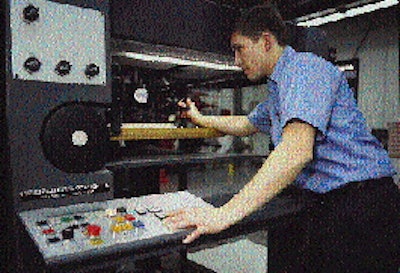Capabilities gained through new machinery can yield a handsome return on investment in the converting world. By adding a six-color sheet-fed offset press with in-line aqueous coating, Chicago-based converter Moss Printing is meeting increasing sheet-fed business demands and using the coating capability to drum up additional opportunities. The new press, added last December, now accounts for 30% of the converter's sheet-fed business. It also increases efficiency and turnaround time, while reducing labor costs. "We initially purchased the Heidelberg because we needed to increase our capacity to meet growing sheet-fed job demands," recalls Rachael Spano, marketing manager. "We looked at several different presses, visited plants and viewed machinery at various trade shows. We selected a machine with the options we needed. It's one of the top names in printing presses and we felt it would provide the durability we needed to take on the additional capacity for the long term." The Heidelberg (Heidelberg, Germany) Speedmaster 102 six-color sheet-fed offset press was installed at Moss's 76ꯠ-sq-ft facility. Within six months the press already accounted for about one-third of the converter's sheet-fed business volume. Moss continues to operate two other six-color sheet-fed offset presses that apply varnish rather than aqueous coating. One of the first jobs to run on the Heidelberg was a full-color box wrap for the board game "Where in the USA is Carmen SanDiego?" Contract packer Chukerman Packaging (Northbrook, IL) applies adhesive to the back of the sheets and laminates the paper wrap onto a 40-pt chipboard carton. The CP then packs game pieces within the carton. Chukerman specializes in manufacturing board games, collectibles, and audio and video cassettes for marketers of such products that lack manufacturing facilities. Quantifiable advantages "We now run about 40 separate products on the Heidelberg for Chukerman Packaging," notes Spano. "The aqueous coating provides durability and scuff-resistance for printed sheets, but most importantly for us, it dries faster than varnish. That lets us move printed material more quickly to the bindery and speed job turnaround time." Moss plant manager Preston Dill adds, "we didn't have aqueous coating capability before, so this equipment helps us draw new business. It also saves us about 25 percent in overall production time, from makeready to curing, compared to our other sheet-fed presses." Time savings begin with better press control. The machine's CPTronic console provides a central digitized electronic control system that makes it easier for operators to run the machine. "Instead of using two people, one attendant can run the press. You don't need somebody to monitor controls on the Heidelberg," he notes. "That saves us about $50ꯠ a year in total labor costs." Spano explains, "The operator can program settings of a job into the computer's memory so that the next time that job runs, the settings can be pulled up immediately." The CPTronic is a modular control system that uses several 16-bit microprocessors and a network of sensors, motors and actuators to monitor virtually all press functions. A control console provides press operators with a central workstation to monitor and diagnose settings such as press speed, run length, and quantity of dampening solution. The Speedmaster 102 accommodates sheet sizes to 28 3/8" x 40 1/8", which is the size Moss uses for "Where in the USA is Carmen SanDiego?" Paper suppliers vary, depending on availability and price, though the material is often a 100# glossy enamel stock. A stack of sheets is placed onto a feeder table. Grippers use vacuum to pick up a single sheet and bring it to the infeed, stream feeder section. These cam-driven grippers align and hold the sheet throughout printing. The top sheet is transported to the first impression cylinder. The image is transferred by inked impression rollers onto a rubber blanket. As the paper moves between the blanket and impression rollers, the image is printed. After passing the first print station, the sheet goes through infrared drying. This process continues for each of the game carton wrap's four colors. Moss uses a combination of alcohol- and water-based inks. At the final station, the printed sheet receives an all-over aqueous coat. The "Where in the USA is Carmen SanDiego?" job runs two-up, at speeds of 8ꯠ sheets/hr. Pallet loads of the printed, coated sheets are shipped to Chukerman for application to the chipboard game carton flats. "Moss used to run this job on another press," recalls Neal Chukerman, president of the contract packager. "It did a nice job, but the aqueous coating seals the sheet instantly. It provides more consistent quality. The finished sheets are more durable and they resist scratching better. That's extremely important to us because we want cartons that are appealing to look at, not scuffed." Moss is well aware that satisfying customers such as Chukerman is no game. The new press improves Moss's efficiency through greater process control and reduced labor costs. Spano says additional future benefits are nearly certain. "One of the high points of the press is that it can be used for perfecting where we can print both sides of a sheet of paper in the same pass. We haven't taken advantage of that yet, but we will. It, too, will save us time and money."



























